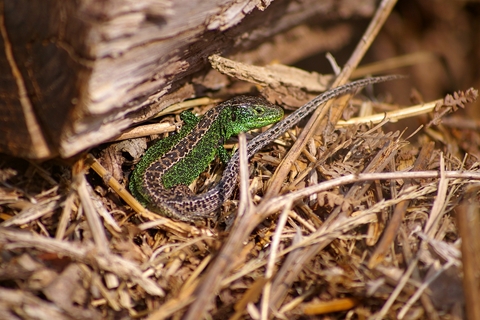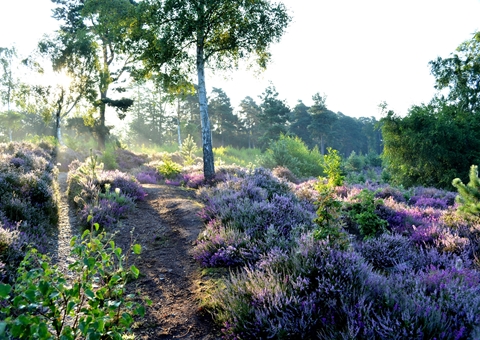 Abraham Lincoln
If given the truth, the people can be depended upon to meet any national crisis...
Abraham Lincoln
If given the truth, the people can be depended upon to meet any national crisis...
 Guildford news...
for Guildford people, brought to you by Guildford reporters - Guildford's own news service
Guildford news...
for Guildford people, brought to you by Guildford reporters - Guildford's own news service
Surrey Wildlife Trust Transforms Heathland Habitat For Rare Sand Lizard
Published on: 27 Jun, 2019
Updated on: 26 Jun, 2019
 A once declining heathland landscape at Wisley and Ockham Common, has been transformed by Surrey Wildlife Trust into a thriving nature reserve of the highest conservation status.
A once declining heathland landscape at Wisley and Ockham Common, has been transformed by Surrey Wildlife Trust into a thriving nature reserve of the highest conservation status.
Awarded favourable condition by Natural England, the reserve is benefitting the UK’s rarest reptile – the sand lizard – which depends on this sandy heathland habitat for its survival.
A fifth of lowland heathland in Europe is found in the UK. However, over the last 200 years Surrey has lost 85% of its heathlands to farming and woodland regrowth, which has decimated the sand lizard population.
At Wisley and Ockham Common, fast growing pine and silver birch tree scrub was taking over when Surrey Wildlife Trust started managing the site.
After more than a decade of scrub clearance and Geographic Information Systems (GIS) mapping of vegetation on the 300 hectare reserve, Surrey Wildlife Trust has created a dynamic heathland landscape. In this mosaic habitat of new and mature heather and gorse, the sand lizard population is expanding steadily with each new generation.
The Amphibian and Reptile Conservation Trust (ARC) rescued 41 sand lizards from a suburban housing development near Bournemouth and began a reintroduction programme at Wisley and Ockham Common in 1991. The sand lizard population is now doing very well.

Sand lizard (Photo: Mike Waite).
The sand lizard has an average life span of 10 years and is up to 20cm in length. Both sexes have brown varied patterns down the back with two strong dorsal stripes.
The male has striking bright green flanks during the breeding season in late April and May. Around June sand lizard females lay their eggs, which are buried in sand exposed to the sun, which helps to keep them warm until they hatch some six to eight weeks later, between late July and early October.
Lowland heathland is a prime location for the rare sand lizard. It provides both mature sunny habitats and open undisturbed sand when well managed. So ARC has helped to create the perfect conditions for females to lay eggs at Ockham Common by creating scrapes of bare sand.
Rob Free, Weald reserves manager of ARC, said: “The whole site was quite overgrown 15 years ago but it’s really transformed now. Old aerial views of Wisley and Ockham Common from 1945 show how we have turned the clock back to its former glory. The heathlands are simply heaving with life at this time of year: invertebrates, bees, wasps, ants and spiders, which sand lizards also love to feed on.”
Surrey Wildlife Trust has achieved success on this nature reserve with help from contractors and volunteers, as well as ARC, to keep down scrub encroachment. Regular grazing on Wisley Common by its herd of belted Galloway cattle help to keep the grasses under control. The hooves of the cattle also create thousands of tiny pockets of bare earth for beetles and burrowing bees to colonise.

Ockham Common (Photo: D. Hawkins).
Zoe Channon, Surrey Wildlife Trust liaison officer at Wisley and Ockham Common, said: “We are so lucky in Surrey to be able to preserve this vast natural wilderness of lowland heathland, which is one of the most ancient British landscapes.
“Carved up into quarters by the A3 and M25 and once facing decline, Wisley and Ockham is now a wildlife haven. It’s so rewarding to spot basking reptiles, especially the sand lizard, warming up in the early morning sun on the miles of sandy pathways. But our work is never done on a site this size.”
Wisley and Ockham Common is part of Surrey Wildlife Trust’s Thames Basin Heaths nature recovery network, which is all about creating a ‘living landscape’ with connective wildlife corridors. The strategy is being developed to transform isolated pockets of wildlife into thriving populations at a landscape scale across Surrey.
Getting to these remarkable reserves is easy, being located at the junction of the M25 and the A3. with parking available at Boldermere Car Park, Pond Car Park & Wren’s Nest Car Park (parking charges apply).
For further information about Wisley and Ockham Common visit www.surreywildlifetrust.org/nature-reserves/wisley-ockham-commons-chatley-heath.
Responses to Surrey Wildlife Trust Transforms Heathland Habitat For Rare Sand Lizard
Leave a Comment Cancel reply
Please see our comments policy. All comments are moderated and may take time to appear. Full names, or at least initial and surname, must be given.
Click on cartoon for Dragon story: Public Asked for Views on SCC’s Proposal for Reduced Speed Limits



Recent Articles
- Notice: Free Bandstand Concerts
- Councillors Hear How the Weyside Urban Village Project Became a Multi-million Risk
- NHS Surrey Issue Heatwave Advice Following Met Office Warning
- Guildford Charity’s Tribute To The Great Stevie Wonder
- Busy First Half of 2025 for Scouting in Guildford
- Dragon Interview: MP Zöe Franklin Reviews Topical Issues
- Letter: Front-line Police Officers Are Heroes But Admin and Comms Need Improvement
- Comment: The 10-year NHS Plan – What Is the Challenge for Guildford?
- Wildlife Group Invites Nature Lovers To Spot and Record Threatened Species
- Esme Campbell, Taking the Mantle of the Dragon’s Newest Reporter


Recent Comments
- Jim Allen on Letter: Front-line Police Officers Are Heroes But Admin and Comms Need Improvement
- George Potter on Letter: A Simple Footbridge Should Have Been Affordable to Keep Towpath Over Weir Open
- Mick McTumshie on ‘Astonishingly Clever’ SCC Show Garden Wins Silver for Turning Parking Spaces Green
- Angela Richardson on Proposed New Leisure Contract Should Improve Facilities and the Council’s Income
- John Redpath on Letter: A Simple Footbridge Should Have Been Affordable to Keep Towpath Over Weir Open
- Jane Austin on Opinion: Waverley Has Failed Spectacularly on CIL
Search in Site
Media Gallery
Dragon Interview: Local Artist Leaves Her Mark At One of England’s Most Historic Buildings
January 21, 2023 / No Comment / Read MoreDragon Interview: Lib Dem Planning Chair: ‘Current Policy Doesn’t Work for Local People’
January 19, 2023 / No Comment / Read MoreA3 Tunnel in Guildford ‘Necessary’ for New Homes, Says Guildford’s MP
January 10, 2023 / No Comment / Read More‘Madness’ for London Road Scheme to Go Ahead Against ‘Huge Opposition’, Says SCC Leader
January 6, 2023 / No Comment / Read MoreCouncillor’s Son Starts Campaign for More Consultation on North Street Plan
December 30, 2022 / No Comment / Read MoreCounty Council Climbs Down Over London Road Works – Further ‘Engagement’ Period Announced
December 14, 2022 / No Comment / Read MoreDragon Interview: GBC Reaction to the Government’s Expected Decision to Relax Housing Targets
December 7, 2022 / No Comment / Read MoreHow Can Our Town Centre Businesses Recover? Watch the Shop Front Debate
May 18, 2020 / No Comment / Read More






Jules Cranwell
June 27, 2019 at 1:33 pm
This is fantastic news.
Unfortunately, all this good work will be undone, if GBC’s Local Plan stays as is, and 3,000 new houses are built at Wisley.
Before anyone says it is not 3,000, look at similar developments, and you will see that numbers are always inflated, once outline permission is granted.
If the UK is to achieve the government’s aim of carbon neutral by 2050, we will need this prime farmland to grow food locally.
The same goes for Blackwell Farm and Gosden Hill.
John Lomas
June 28, 2019 at 8:44 pm
“If the UK is to achieve the government’s aim of carbon neutral by 2050, we will need this prime farmland to grow food locally.”
That photo is showing strange looking “Prime Farmland”!
Jules Cranwell
June 29, 2019 at 4:09 pm
Wheat for six million loaves of bread is grown on the proposed Wisley site annually.
Gordon Bridger
July 2, 2019 at 9:31 am
But hold on a moment this is a Special Protection Area from which visitors are supposed to be discouraged as they threaten three endangered bird species – the Dartford Warbler, the Nightjar and the Woodlark. Special Areas of Natural Greenspace (agricultural land and other Greenbelt areas) have been allocated to encourage visitors NOT to go to Wisley (and Whitmoor).
So great is the threat that around £70m is likely to be collected in the next 15 year housing plan to provide new spaces to discourage visitors to Wisley – the fact that the three species of birds were virtually wiped out several years ago has not worried Natural England as they claim that local residents “and urbanization” were destroying their habitats – yet the Surrey Wildlife Trust is now being congratulated for restoring them and encouraging visitors to them.
Meanwhile, developers are told they can build on Greenbelt if they provide SANGS – regardless of the fact that there are no birds to protect and that in fact they areas which local people have been “destroying” are now flourishing.
Patrick Haveron
July 3, 2019 at 1:31 pm
Come on Gordon – understand the Natural England guidance. No building within 1km of a SPA, and SANG mitigation within 5km. Might seem over the top strategy, but at least it is a strategy.
The alderman should know full well that fires could wipe out these sensitive species straight away, and that Dartford warblers are very susceptible to cold winters (a crazy warbler that doesn’t migrate), and that woodlarks only feed on bare closely cropped heather – hence the need for management.
Itks a very delicate eco-system that could easily be upset by overuse by humans. The boardwalks at Thursley Common Elstead are a great way of managing human access to these wonderful heaths (and worthy of SANG funds too!).
John Perkins
July 4, 2019 at 10:17 am
Protection legislation predates SPA, Natural England (NE) and SANG by several decades. It’s necessary because people recognise that some humans must be prevented from destroying their environment, even if only inadvertently by existing in excessive numbers.
Like all bureaucratic efforts, legislation can be misused and the more complex it is, the easier the misuse.
SANG (invented by NE) is a perfect example. It’s now used to justify human development in places near to “protected” areas, thus ensuring that eventually SPAs will be surrounded by housing estates interspersed by small parks and gardens.
If Gordon Bridger appears sarcastic then that’s only because he recognises the irony.